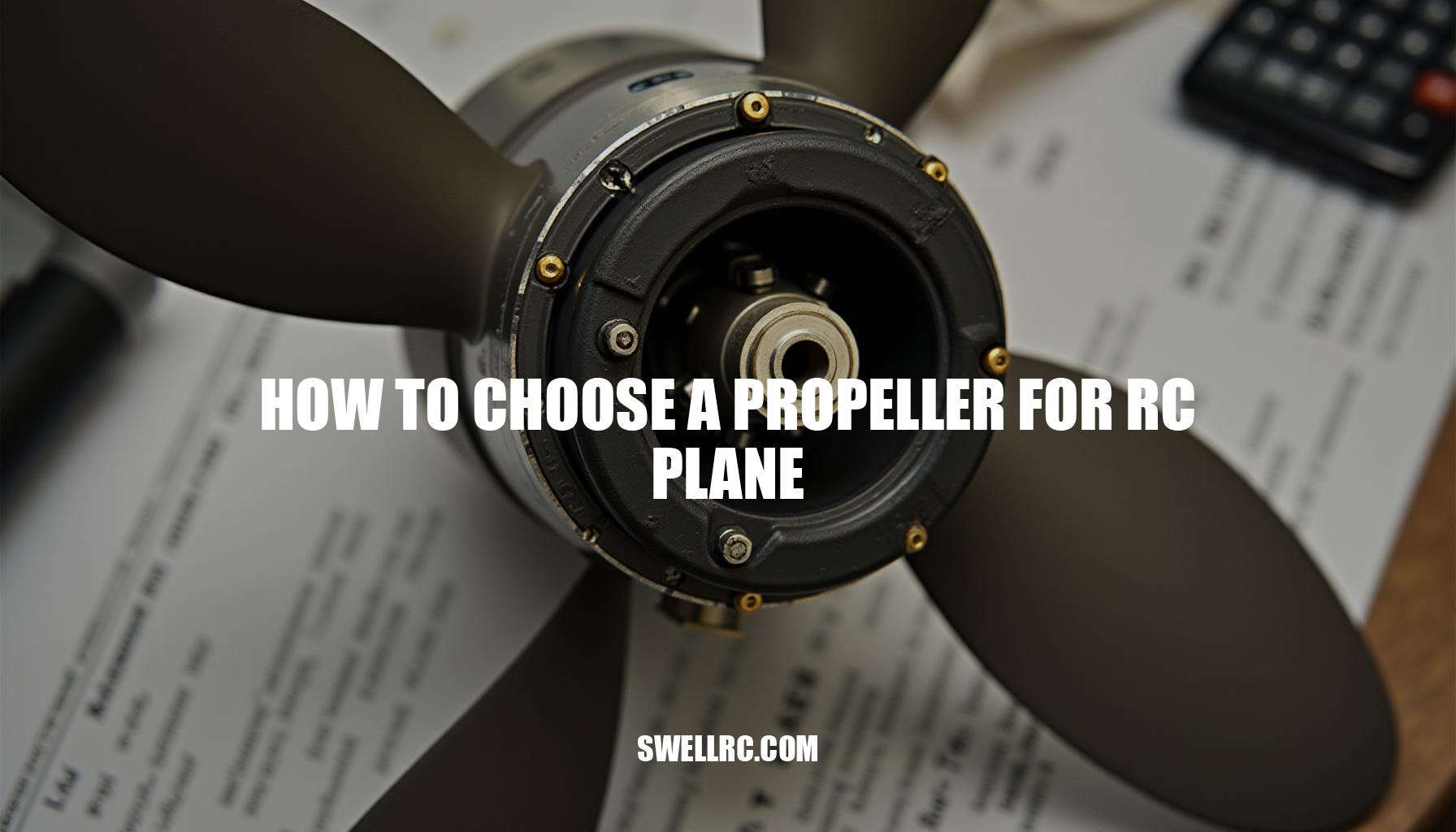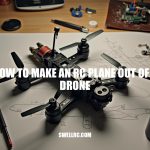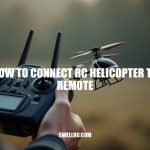How to Choose a Propeller for RC Plane
The first time I swapped out the propeller on my electric-powered RC plane, it was like unlocking a hidden secret—the plane responded instantly with a quicker takeoff, a smoother climb, and a noticeably quieter cruise. It felt like it suddenly came alive. At its core, an RC airplane propeller is what converts motor power into thrust, and two crucial numbers define much of how your plane performs in the air: the diameter and the pitch.
Think of diameter as the size of the prop sweeping through the air, and pitch as the distance the prop would theoretically move forward in one rotation. Choosing the right propeller pitch and propeller diameter isn’t just science—it’s also a tinkerer’s joy, blending bench data with real-world flight testing to find the sweet spot. Of course, your prop choice must align perfectly with motor sizing and current limits to ensure both safety and peak RC flight performance.
For a solid foundation in matching motors to props, check out our detailed motor-sizing overview at https://www.swellrc.com/how-to-size-electric-motor-for-rc-airplane/. Whether you’re new or experienced, beginners can achieve great results by starting with recommended RC airplane propellers and iterating safely as they learn. Embrace this rewarding process, and watch your electric-powered RC planes transform with every informed adjustment to their propulsion systems.
Understanding Propeller Basics: Pitch, Diameter, and Materials Explained
Understanding propeller diameter and propeller pitch is key to dialing in your RC airplane’s performance. The diameter is the disk size—the length of the blade from tip to tip—that “grabs” air; bigger diameters move more air and generally create more static thrust. Pitch, measured in inches, represents the theoretical forward distance the prop would travel in one revolution if it were moving through a solid—think of it as the “speed setting.” For example, a 9×4.7 propeller spins 9 inches across and moves you theoretically 4.7 inches per turn, while a 10×6 prop is larger and will “push” farther per revolution.
This means the 9×4.7 tends to give stronger acceleration and shorter takeoffs, while the 10×6 can reach higher top speeds but might draw more current and need more power.
Prop numbers often include suffixes like E, which stands for electric, indicating the prop is optimized for electric motors. Slow-fly props usually have lower pitch and sometimes smaller diameter, enhancing thrust and control at low speeds, whereas speed props have higher pitch for greater velocity but at the cost of increased amp draw.
After burning through multiple props testing pitch combos, I learned that a single inch of pitch can feel like shifting gears on a bike—small changes in pitch dramatically shift how your plane accelerates and cruises.
| Aspect | Small Diameter | Large Diameter | Low Pitch | High Pitch | Material Differences |
|---|---|---|---|---|---|
| Static Thrust | Lower | Higher | Higher | Lower | Plastic: moderate thrust |
| Top Speed Potential | Lower | Higher | Lower | Higher | Wood: good thrust, quieter |
| Amp Draw | Lower | Higher | Lower | Higher | Carbon: highest efficiency, stiffest |
| Acceleration | Better initial acceleration | Slower initial acceleration | Better acceleration | Less initial torque | Plastic: durable, noisy |
| Takeoff Distance | Shorter | Longer | Shorter | Longer | Wood: moderate cost, less durable |
| Carbon: expensive, very durable |
Material choice affects RC motor efficiency and durability: plastic or nylon props excel in durability and cost-effectiveness but generate more noise and are less stiff, resulting in slightly lower efficiency. Wood offers quieter operation and decent efficiency but is more fragile. Carbon fiber props are stiff, highly efficient, and durable but can be noisy and pricier.
Finally, remember that motor construction and winding style heavily influence which props work best with your setup. Brushed, brushless outrunner, and inrunner motors have different torque and RPM characteristics, so matching your propeller diameter and pitch to your motor’s capabilities can optimize your plane’s performance and battery life. For detailed insights into matching propellers with RC motors, check this guide on RC electric motors for airplanes.
Matching Propeller to Motor and Aircraft Type
When choosing an RC motor and prop combo, several factors guide your propeller selection, notably the motor’s electric motor kv rating, battery voltage, aircraft weight, and its intended mission—be it trainer, sport, aerobatic, glider, or pylon racer. Generally, a lower kv motor paired with a higher voltage battery favors swinging larger diameter props at moderate speeds for efficient thrust generation, while higher kv motors prefer smaller diameter props spinning faster to achieve optimal performance.
Understanding the difference between static vs. dynamic thrust is key: static thrust is the propeller’s pull when the aircraft is stationary (on the bench), whereas dynamic thrust is the effective thrust experienced in flight as the plane moves forward. A propeller might appear weak during bench tests due to limited airflow, but once airborne and moving, the increased airspeed can “wake up” the prop’s performance, sometimes pleasantly surprising you.
For example, I once tested a prop that over-amped the motor on the bench, indicating excessive current draw and potential risk, but after dialing back the pitch by just one inch, it flew beautifully with improved efficiency and responsiveness in flight. This highlights the importance of balancing prop size and pitch to match your motor and avoid pushing beyond recommended current limits.
For glider-specific builds, folding props with larger diameters and modest pitch work best to maintain quiet, efficient soaring power without undue drag. These setups rely on smooth, sustained thrust rather than raw speed—see soaring power setups at SwellRC’s glider motor guide for detailed recommendations.
Speed-focused aircraft tend to use smaller diameter props with higher pitch to maximize forward velocity, providing aggressive thrust when paired with the right motor and voltage combination. For more on matching props to fast RC planes, check SwellRC’s speed performance considerations.
To help you get started, here’s a quick reference list that maps typical motors to suitable starting prop ranges based on common kv ratings and battery setups, emphasizing thrust-to-weight ratio and current limitations:
- 2204–2306 (2300–2600 kv, 3–4S): 5×3 to 6×4
- 2212–2216 (~900–1400 kv, 3S): 9×4.7 to 10×5
- 2812–2820 (~800–1100 kv, 3–4S): 10×5 to 12×6 (watch amps carefully)
- 35xx (600–900 kv, 4–6S): 12×6 to 14×8 for heavier sport/scale models
- Gliders (~700–1000 kv, 3–4S): Folding 11×6 to 13×7
Note: Always verify your setup with a wattmeter to measure actual power consumption and ensure it stays within your motor and ESC specifications for longevity and safe operation. Matching the electric motor kv rating to prop size, battery voltage, and flight mission is crucial for achieving optimal RC flight performance and the right thrust-to-weight ratio.
Testing and Fine-Tuning: The Trial-and-Error Method
Validating a propeller on the bench before the maiden flight is essential to ensure optimal battery draw, ESC safety, and overall performance. Here’s a safe, repeatable workflow to dial in your setup:
- Inspect prop for defects: Check for cracks or chips, confirm the correct rotation, and make sure the numerical markings face forward. This prevents installation mistakes that can affect thrust and safety.
- Mount securely: Verify that the spinner and adapter torque is correct and that the collet seats properly. Improper mounting leads to vibration and inaccurate RPM reading during RPM testing.
- Use a wattmeter: Gradually throttle up while logging current, watts, RPM, and thrust using an optical tach or suitable app. Performing a static thrust test gives valuable metrics for comparison against motor and ESC limits.
- Compare readings: Check your recorded values against the motor and ESC specifications, maintaining a 10–20% safety margin to protect your gear from overheating or overload.
- Adjust prop dimensions if needed: If current draw is too high, try stepping down one inch of pitch or diameter and retest. Small changes can tame current draw or boost acceleration, balancing performance and longevity.
- Balance the prop: Proper prop balancing reduces vibration and noise, improving efficiency and protecting mechanical components. General balancing principles apply across RC props; see these fundamentals at https://www.swellrc.com/how-to-balance-rc-boat-prop/.
- Reinstall carefully: Follow detailed instructions for mounting and safety orientation found in this guide: https://www.swellrc.com/how-to-install-propeller-on-rc-plane/. Proper installation prevents accidents, as props can bite if mishandled.
- Validate in short flights: Monitor motor, ESC, and battery temperatures upon landing to ensure no overheating. Remember, temperature and altitude can skew bench test results, so field validation is critical.
- Finalize control setup: After trimming, ensure consistent control responses. Matching servo torque and speed helps the plane track cleanly—check out https://www.swellrc.com/how-to-choose-servos-for-rc-plane/ for recommended servo selection tips.
Friendly safety reminder: Always handle props with caution. They are powerful and can cause injury. Using this workflow, you can achieve reliable measurements and protect your gear.
Personal lesson learned: I once backed off one inch of pitch to cool my ESC without sacrificing climb performance. This small change made a significant difference, demonstrating how fine-tuning prop specs can optimize both power and component longevity.
Common Mistakes and How to Avoid Them
When it comes to troubleshooting RC prop setups, many of us have faced the frustrating moment where a simple oversight leads to ESC overload or fried electronics. I once underestimated how much torque a higher-pitch prop could demand—my wattmeter told the truth before the smoke did. To help you avoid such pitfalls and keep your flights safe and efficient, here’s a practical checklist addressing common issues and quick fixes:
- Ignoring motor/ESC current limits: Always verify your system’s current draw with a wattmeter and consult your motor and ESC datasheets to stay within safe operating parameters.
- Too much diameter or pitch: Oversized props can cause over-amps, overheating components, and short flights—drop one step in size or pitch and retest for optimal performance.
- Using the wrong prop type (glow/IC vs electric): Use only electric-rated props on e-motors to prevent compatibility issues and ensure safety.
- Unbalanced props: An unbalanced prop leads to vibration, excessive noise, and premature bearing wear—use balancing tools before every flight to minimize these effects.
- Incorrect rotation or mounting backward: Always confirm that the pitch markings face the direction of travel; reversed props degrade thrust and strain your electronics.
- Inadequate ground clearance: Props that are too low risk strikes on grass or rough fields—consider reducing diameter or adding landing gear height.
- Overlooking ESC timing and throttle calibration: Recalibrate your ESC regularly and adjust timing settings to achieve smooth power delivery and prevent overloads.
- Battery C rating too low: Using batteries with insufficient burst and sustained current ratings causes voltage sag and overheating—upgrade packs to meet the demands.
- Treating all RC props the same: Component compatibility varies across RC categories; for example, boat and helicopter drives require purpose-built parts (see examples here and here), emphasizing the importance of selecting correct props for your specific application.
- Skipping post-flight temperature checks: Always perform a touch test or use an IR thermometer scan after your first flights to detect overheating early.
By running through this checklist, you can reduce costly errors, improve safety checks, and ensure long-lasting, trouble-free performance of your RC setups.
Material Matters: Choosing the Right Construction for Your Propeller
Choosing the right propeller materials for your RC plane can significantly impact your flying experience by aligning with your environment, budget, and performance goals. When comparing plastic/nylon (including glass-filled variants), wood, and carbon fiber, it’s important to consider factors like stiffness, vibration, noise, durability, repairability, and cost.
Foam airframes especially benefit from smoother, lower-inertia props during initial tuning phases, making forgiving materials such as plastic or wood ideal. On the other hand, carbon fiber props excel in high-power builds or precision aerobatics due to their superior stiffness and balance stability. Lightweight planes often pair best with materials that balance durability and reduced vibration, ensuring efficient and responsive flights.
| Material | Pros | Cons | Best For | Notes |
|---|---|---|---|---|
| Plastic/Nylon (including glass-filled) |
|
|
Trainers, Beginners, Scale models | Generally quieter; easier to find balanced props; forgiving on foam airframes |
| Wood |
|
|
Scale models, Sport flying, Intermediate pilots | Produces natural sound; stable balance; decent efficiency at moderate RPM |
| Carbon Fiber |
|
|
High-power racing, Precision aerobatics, Advanced builds | Maintains balance at high RPM; sharper efficiency; requires careful handling and tuning |
Ultimately, selecting nylon vs wood vs carbon comes down to what you prioritize: budget-friendliness and reliability favor plastic/nylon; natural feel and repairability lean toward wood; and ultimate performance shines with carbon fiber. For those building lightweight models, pairing your choice of prop material with a suitable airframe is crucial — check out this guide on the best foam for RC planes to ensure your build is optimized for vibration control and efficiency.
Final Tuning Checklist: From Workshop to Sky
Embarking on your maiden flight with a new prop setup is an exciting milestone where all your diligent tinkering truly pays off. To ensure safe, repeatable success, follow this concise, confidence-building pre-flight checklist that emphasizes installation correctness, prop balancing, and optimal motor sizing. This easy-to-save guide helps affirm that your pitch-diameter balance is within safe limits and that everything is primed for smooth, reliable operation.
- Prop size/pitch validated on a wattmeter and confirmed to be under limits, with a healthy 10–20% headroom for safety margins.
- Prop balanced
- Ensure adequate ground clearance plus sufficient cowl and airframe clearance to avoid damage during engine run-up or taxi.
- Motor and ESC firmware updated with timing settings optimized; throttle endpoints set precisely and ESC fully calibrated for smooth throttle response.
- Battery health verified with appropriate C rating; observe no excessive voltage sag under test loads.
- Control surfaces move smoothly with servos centered; endpoints and rates verified to eliminate surprises in flight.
- Set the center of gravity carefully tuned for your intended mission whether trainer, aerobatic, or speed-focused flight.
- Range check completed; failsafe protocols engaged; telemetry and alarms configured for real-time safety feedback.
- Record baseline data meticulously: prop size, RPM, current (amps), power (watts), temperatures, and detailed flight notes to track performance and improvements.
- Plan the first flight with gentle climb-outs, short full-throttle bursts (WOT), and immediate landing to recheck temperatures and system behavior.
Print or save this checklist as your trusty flight companion; adhering to this regimen guarantees peace of mind so you can focus on enjoying your aircraft’s first successful flight and every flight thereafter.
Conclusion: The Joy of Getting It Right
Discovering the airplane’s sweet spot with the best RC propeller combinations is an incredibly satisfying part of the personal testing journey. The right propeller can transform your flying experience—making your plane float longer, climb straighter, or even sprint faster with less noise, elevating your RC flight performance to new heights. Embrace the spirit of continual improvement by changing just one variable at a time, carefully logging your results, and celebrating each little success along the way.
Remember, every aircraft and flying field presents unique challenges and opportunities.
The best prop is the one that suits your specific purpose, respects your current skill and equipment limits, and most importantly, brings a smile to your face when you land.
We encourage you to share your setups and lessons learned — your experiences could inspire fellow enthusiasts to find their perfect mix too. So get out there, experiment methodically, and enjoy the rewarding journey of fine-tuning your model’s performance with confidence!
Frequently Asked Questions
- What size propeller should I use for my RC plane?
Start with the motor manufacturer’s recommended sizes, then fine-tune for your airframe and mission. As a rough guide: small 2204–2306 motors (3–4S) use 5×3–6×4; 2212–2216 (3S) use 9×4.7–10×5; 2812–2820 (3–4S) use 10×5–12×6. Always verify with a wattmeter and ensure current stays within motor/ESC limits. - How does propeller pitch affect flight speed and thrust?
Pitch is the theoretical distance the prop moves forward per revolution. Higher pitch pushes more air per turn, raising potential top speed but increasing current draw and reducing low-speed punch. Lower pitch improves static thrust and acceleration, often at the expense of top-end speed. - Can I use any propeller with my electric RC motor?
No. Use electric-rated props sized to keep current within the motor and ESC limits, with enough ground and airframe clearance. Match diameter and pitch to the motor’s kv and battery voltage, and always confirm on a wattmeter. - What is the difference between a two-blade and three-blade propeller?
Two-blade props are typically more efficient and draw fewer amps for a given thrust. Three-blade props fit more blade area into a smaller diameter for better thrust in tight clearances and can reduce noise pitch, but they usually draw more current and may be less efficient. - How do I balance and install a new RC propeller?
Use a prop balancer; lightly sand or add small drops of clear tape/CA to the light blade until both sides rest level. Install with the size markings facing forward, tighten the adapter/spinner securely, verify rotation direction, and run a brief low-throttle test while checking for vibration. - How does motor kv rating influence propeller choice?
Lower kv motors generally turn larger-diameter or higher-pitch props efficiently (especially on higher voltage), while higher kv motors prefer smaller props at higher RPM. Always select a prop that keeps current within specs for your motor, ESC, and battery.



